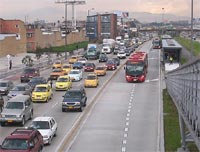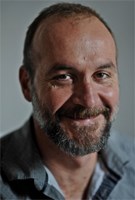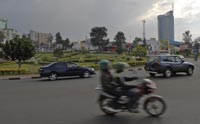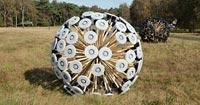[Design Indaba 2012] Invest in people
Andrew Boraine (@andrewboraine), chief executive of the Cape Town Partnership focusing on the regeneration of the Cape Town Central City, was attending the South African City Leadership Programme in Stellenbosch and keeping his followers updated on Twitter. It was wonderful getting a double dose of inspiration from Boraine's tweets while I sat listening to speakers at the indaba.
So nearby, SA mayors were listening as Enrique Peñalosa spoke about his tenure as one of the transformative mayors of Bogota. In just 10 years, he and his forerunner Antanas Mockus turned one of the most dangerous and corrupt capitals in the world into a peaceful city populated by caring citizens.
Changing civic culture

Mockus was first instrumental in changing civic culture with his Cultura Ciudadana (Citizen Culture) campaign encouraging civic behavior and enhancing a sense of belonging for the inhabitants of Bogota. Peñasola picked up where he left off, with numerous changes, including the relocation of informal vendors, improvement and construction of parks, renovation of major roads and a mass transit system.
Some of his more progressive policies have been controversial, such as the restriction of rush-hour circulation that means private vehicles with number plates ending in certain numbers can not circulate on specific days of the week. Another has been raising sidewalks and installing bollards to prevent cars from parking there and encourage people to use public transport. "Parking is not a constitutional right," declared Peñasola.
In conjunction with this, Peñasola has had dedicated bus lanes constructed with barriers separating them from private vehicles, as well as protected bicycle lanes, throughout the city. "A protected bicycle way is a symbol of democracy," he said, "A person with a US$30 bicycle becomes equal to a person in a US$30 000 car."
Documentary expounded on Peñasola's initiatives
Screened during the Design Indaba week, the documentary Urbanized expounded on Peñasola's initiatives.
Watching the buses in Bogota speed by the slow creep of rush hour is a delight. Peñasola believes that a bus with 100 occupants has 100 times more right to be on the road than a car with one occupant. In another scene, the former mayor talks to camera as he pedals along a smooth bicycle lane. He smiles as he whizzes past a car struggling to negotiate the potholes of a neglected road and he makes it clear that that road is not his first priority.
A bold man indeed, but his strategy worked.
First African city to win
Another of the mayors on the panel was Aisa Kirabo Kacyira, mayor of Kigali, Rwanda, 2006-2011. Under her leadership, Kigali became the first African city to win the UN-HABITAT Scroll of Honour Award "in recognition of the high level of cleanliness, greenness, safety and the sustainable, affordable housing initiatives combined with pro-poor urban employment opportunities".
Her initiatives to improve Kigali were arguably as bold as Peñasola's. If you arrive there today, any plastic bags are confiscated at the airport before you can enter the city. The city is spotless. The boulevards are lined by nicely trimmed trees and traffic flows smoothly, largely because of an army of motorcycle taxis and a thriving bus and taxi system. You are often within eyesight of an armed policeman which enhances citizen's safety. On Saturday mornings, all citizens take part in Umuganda, a nationwide initiative in which neighbours come together to pick up litter, cut grass, trim trees, and even help build schools.
Through this, civic pride is instilled in the citizens of Kigali and the greatest benefit is that social barriers are crossed because all citizens take part, from taxi drivers to government officials; doctors to priests; Hutus to Tutsis.
Profound benefits to citizens
As bold and controversial as their initiatives are, the benefits to the citizens are profound. As Peñasola states, "We invested in people."
Many of the ideas, designs and initiatives presented at Design Indaba were as bold and often more so. Yet the design world is only as successful as the people who buy the ideas and implement them. Clients like these are hard to come by, as many of the presenters alluded to.
One supposes designers should appeal to clients to respect their talent and expertise; that they should trust them. As shown at the indaba, the best solutions often come from taking risks; not giving people what they expect and thereby changing their perspective. This has been proven time and again but it is a tough argument for clients who want a guaranteed return. Only the very bold will embrace this strategy.
Designers involving people more than ever
The truth is designers are involving people more than ever in their work. Where digital is excelling is in the facility to accumulate fundamental data about people's behaviour. Ever-expanding digital tools mean people can interact with one another on more "human" levels across the internet.
In the physical world, designers are putting people first and involving them deeply in their creations by stimulating their physical senses and imagination. The most stimulating work presented was often "low tech" creations that people could freely interact with.
What we are seeing is the humanisation of design, so perhaps it is to the client's sense of humanity that designers and advertising practitioners should appeal; persuade them to stop looking at people as target markets and create work that invests in people, as Peñasola did.
No easy task
Yet it is no easy task.
Discussing his remarkable landmine-clearing machine, a model based on a wind-driven toy from his childhood in Afghanistan, Massoud Hassani is struggling to get finance for research and improvement of the machine.
The point of the device is to minimise the manpower and cost involved (he predicts the device could be built for just US$40), as well as the time it takes to clear a minefield, yet these can be barriers to it being financed and accepted.
Organisations involved in mine clearing are relatively well-financed with aid money. The people doing the work are paid a steady income and, even though the work is somewhat dangerous, it is a long-term job. Why help develop a device that would eradicate that? Many aid organisations have proven to be self-serving and therefore inneffective in their goals.
But I'm not just talking about humanitarian projects such as this.
Ability to tell the truth
At the core of humanity is the ability to tell the truth.
As more and more people worldwide have access to information, it is harder to hide behind a brand name or a jingle. Obviously, this applies to advertising and there is a serious lack of truth in the paid media. Organisations which ignore this are going to lose relevance in a society that is demanding openness and honesty.
It is becoming clearer which organisations invest in themselves. Invest in people and we all move forward.
For more:
- Bizcommunity special section: Design Indaba
- Bizcommunity twitterfall: Design Indaba
- Design Indaba website: www.designindaba.co.za
- Facebook: Design Indaba
- Twitter: @DesignIndaba
- Twitter Search: Design Indaba OR designindaba OR DI2012
- Google News Search: Design Indaba







































